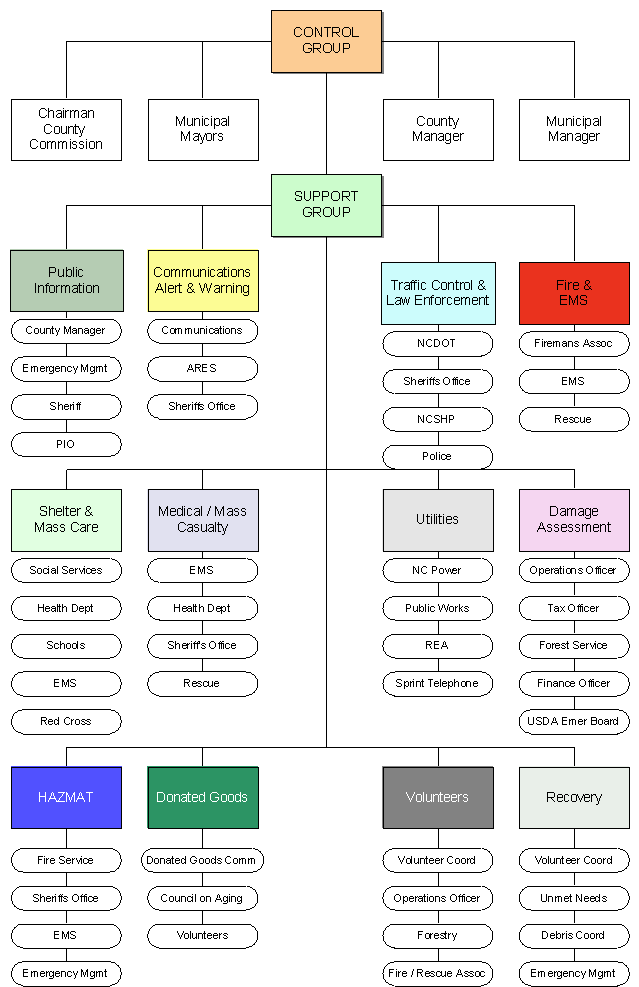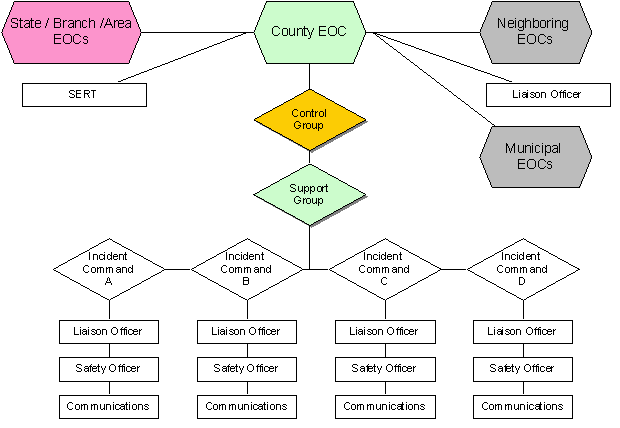|
|
|
I. |
PURPOSE
This annex outlines
the direction and control procedures for
emergency operations and identifies the
personnel, facilities and resources which will
be utilized in the coordinated response
activities.
|
|
II. |
SITUATION AND ASSUMPTIONS
|
| |
A. |
Situation:
|
| |
|
1. |
Direction and control of normal day-to-day
emergencies is performed by senior on-scene
emergency response personnel (i.e., law
enforcement, fire, rescue, EMS) in accordance
with local ordinances, policies and procedures.
|
| |
|
2. |
Many hazards exist within or near the
County which have the potential to cause
disasters of such magnitude as to warrant
centralization of the direction and control (Emergency
Operations Center) function in order to
conduct effective and efficient emergency
operations.
|
| |
|
3. |
Centralized county‑wide direction and control
(Emergency Operations Center activation) is
desirable when one or more of the following
situations occur:
|
| |
|
|
-
there exists an imminent
threat to the safety or health of the
public;
-
extensive
multi‑agency/multi-jurisdiction response and
coordination is necessary to resolve or
recover from an emergency or disaster
situation;
-
local resources are
inadequate or depleted and significant
mutual aid, state and/or federal resources
must be utilized to resolve the emergency or
disaster situation;
-
the disaster affects multiple
political jurisdictions within the County
which are relying on the same emergency
resources to resolve the emergency or
disaster situation;
-
local emergency ordinances
are required and implemented to control the
emergency situation.
|
| |
|
4. |
The type and magnitude of any emergency event
occurring in
Bertie
County or a municipality within
the County will dictate the need to activate the
EOC.
|
| |
|
5. |
The County Emergency Operations Center serves as
the central direction and control point for
county‑wide emergency response activities.
|
| |
|
6. |
The primary County Emergency Operations Center
(EOC) is
located at 106 Dundee Street in Windsor.
|
| |
|
7. |
In the event the primary Emergency Operations
Center is inoperable, an alternate Emergency
Operations Center may be established in the
Windsor Fire Department or other appropriate
location.
|
| |
B. |
Assumptions:
|
| |
|
1. |
The designated Emergency Operations Center will
be activated upon the threat or occurrence of a
major emergency/disaster and designated
personnel will report to the Emergency
Operations Center in a timely fashion.
|
| |
|
2. |
The County Emergency Operations Center facility
and equipment is adequate for coordinating
county‑wide emergency operations.
|
| |
|
3. |
Sufficient procedures have been developed to
effectively direct and control disaster
operations/recovery.
|
| |
|
4. |
Emergency operations and coordination at all
levels of government will be carried out
according to plans and procedures.
|
| |
|
5. |
All Municipalities will probably not send a
representative to the
County
EOC.
|
| |
|
6. |
Municipalities will maintain communications with
the
County
EOC via telephone, radio or fax.
|
| |
|
7. |
Municipalities will act in unison with the
County on such issues as proclamations, public
information and evacuations.
|
|
III. |
CONCEPT OF OPERATIONS
|
| |
A. |
General
|
| |
|
1. |
Emergency operations shall include all
activities which are directed toward reduction
of the immediate hazard, establishing situation
control and restoration of normal operations
within the County.
|
| |
|
2. |
The responsibility for the direction and control
of disaster situations is vested in the County
Board of Commissioners and is routinely
exercised through the Emergency Management
Coordinator or the County Manager.
|
| |
|
3. |
The
Emergency Management Coordinator will
activate, organize and operate the Emergency
Operations Center in a flexible manner based on
the magnitude of the situation.
|
| |
|
4. |
The organizational structure of the
Emergency Operations Center
will be arranged according to the type of
incident, agencies and/or jurisdictions
involved, objectives and strategies selected to
resolve the situation and the demands of the
emergency. Municipalities, when needed, will
provide representation in the County Emergency
Operations Center for inter-jurisdictional
coordination when the event severely affects the
jurisdiction, or as requested.
|
| |
|
5. |
The Chairman of the Board of Commissioners and
County Manager will be notified by the Emergency
Management Coordinator when Emergency Operations
Center activation is warranted to direct and
control emergency operations.
|
| |
|
6. |
The Emergency Operations Center is the
operational area from which emergency response
activities can be directed, controlled and
coordinated and utilizes the facilities of the
County Communications Center. It will be managed
in accordance with the County Emergency
Operations Center Standard Operating
Procedures.
|
| |
|
7. |
On-scene activities of emergency response
personnel will be managed utilizing the Incident
Command System.
|
| |
|
8. |
Municipalities within the County may exercise
independent direction and control of their own
emergency resources, outside resources assigned
to them by the County Emergency Operation Center
and resources secured through existing mutual
aid agreements with other jurisdictions. All
requests for state or federal assistance will be
directed to the County Emergency Management
Coordinator.
|
| |
|
9. |
The Bertie County EOC may be activated by the
Chairman of the Board of County Commissioners or
his designee, the County Manager or his
designee, or the Emergency Management
Coordinator.
|
| |
|
10. |
Municipal EOCs will be activated by the Mayor or
Mayor�s designee, or the Emergency Management
Coordinator.
|
| |
|
11. |
Emergency operations and coordination at all
levels of local government will be carried out
according to existing standard operating
procedures.
|
| |
|
12. |
Notification of County EOC personnel is the
responsibility of the Emergency Management
Coordinator.
|
| |
|
13. |
Operational readiness of the County EOC is the
joint responsibility of the Emergency Management
Coordinator and the Chief of the Windsor Fire
Department.
|
| |
|
14. |
Notification of Municipal EOC personnel is the
responsibility of the Mayor or Mayor's designee.
|
| |
|
15. |
Operational readiness of Municipal EOCs is the
responsibility of the Mayor or Mayor's designee.
|
| |
|
16. |
Administrative decisions regarding food,
supplies and other incidental needs for the
County EOC during activation is the
responsibility of the Operations Officer.
Similar administrative decisions regarding
municipalities will be the responsibility of the
Mayor or Chief elected official.
|
| |
|
17. |
Upon activation of any Municipal EOC, the
Municipality will establish communications with
the County EOC and/or Communications Center, who
will in turn notify the Emergency Management
Coordinator.
|
| |
|
18. |
Whenever an EOC is activated or activation of an
EOC appears imminent, the County Emergency
Management Coordinator will in turn notify the
Division of Emergency Management.
|
| |
|
19. |
Frequent staff briefings will be conducted for
EOC staff.
|
| |
B. |
Staffing
The name of the
group may change as well as its' composition,
but the functions will remain the same. "Groups"
will also work in close association with one
another, often sharing the same physical space
and often crossing groups to work with and
coordinate with others.
Personnel reporting to the County
EOC will operate in one of two functional
sections assigned or predetermined by the
Operations Officer.
|
| |
|
1. |
The Control Group,
under the direction of the Chairman of the Board
of County Commissioners, or his designee,
consists of the decision makers of the
jurisdiction and others as decided by the
Chairman. This group is responsible for:
-
The approval of policies and
strategies pertinent to the emergency
situation.
-
Leadership and
decision-making (for implementation by the
Support Group).
-
Preparation and release of
statements to the general public in
coordination with the Public Information
Officer.
-
Maintaining a line of
communication with their respective
administrators and County/Municipal elected
officials utilizing communications equipment
available.
-
Upon activation, maintaining
a presence in the EOC to carry out the
direction and control function.
-
Maintaining an awareness of
the overall actions being taken in response
to the emergency situation.
|
| |
|
2. |
The Support Group,
under the direction of the Control Group is
responsible for on-scene operations including
the allocation of resources. The Support Group
may consist of the following Sub Groups
(Emergency Support Functions) and state agency
representatives:
-
Information:
Sheriff, Emergency Management Coordinator,
Public Information Officer and County
Manager.
Group Leader:
County
Manager.
-
Communications/Notification
and Warning:
Bertie County Communications, Amateur Radio
and Sheriff's Office.
Group Leader:
Sheriff's Office.
-
Traffic Control/Law
Enforcement/Emergency
Transportation: Sheriff's Office,
N.C. Highway Patrol, Municipal Police
Departments and N.C. Department of
Transportation.
Group Leader:
Sheriff's Office.
-
Fire and EMS:
Fire Association President and Emergency
Medical Service.
Group Leader: Fire
Association President.
-
Shelter/Mass Care:
Department of Social Services, Health
Department, Emergency Medical Service,
Superintendent of Schools and American Red
Cross.
Group Leader:
Department of Social Services.
-
Medical Emergency/Mass
Casualty:
Health Department, Emergency Medical Service
and Sheriff's Office.
Group Leader: Health Department.
-
Utilities:
Operations Officer, Public Works,
North Carolina Power, Rural
Electric Association (REA), and
Sprint-Carolina Telephone.
Group Leader: Operations Officer.
-
Damage Assessment:
Operations Officer, Tax Officer, Finance
Officer, Red Cross, Forest Ranger, U.S.D.A.
Emergency Board Member and Management
Information Systems.
Group Leader: Tax Officer.
-
HazMat:
Fire Service Representative, Sheriff's
Office, Emergency Medical Services and
Emergency Management Coordinator.
Group Leader: Emergency Management
Coordinator.
-
Donated Goods/Unmet Needs:
Donated Goods Committee, Council on Aging
Director and Volunteers.
Group Leader:
Council on Aging Director.
-
Volunteers:
Volunteer Coordinator, Operations Officer,
Forestry, Fire Association President and
Rescue Association President.
Group Leader:
Volunteer Coordinator
-
Recovery:
Volunteer Coordinator, Unmet Needs Chairmen,
Debris Coordinator, Donated Goods
Coordinator, Emergency Management
Coordinator, Finance Officer and Tax
Officer.
Group Leader: Emergency Management
Coordinator.
|
|
IV. |
CONTINUITY OF GOVERNMENT |
| |
A. |
Staffing assignments for positions in the
Emergency Operations Center will allow for
continuous 24-hour operations. Selection and
assignment of personnel will be the
responsibility of the agency.
|
| |
B. |
In the event that the primary Emergency
Operations Center is not functional, an
alternate Emergency Operations Center will be
activated. |
| |
|
|
|
|
Attachment 1
Direction and Control Organization Chart
|
|
|
 |
| |
|
Attachment 2
Incident Command Structure
|
| |
|

|
|
|